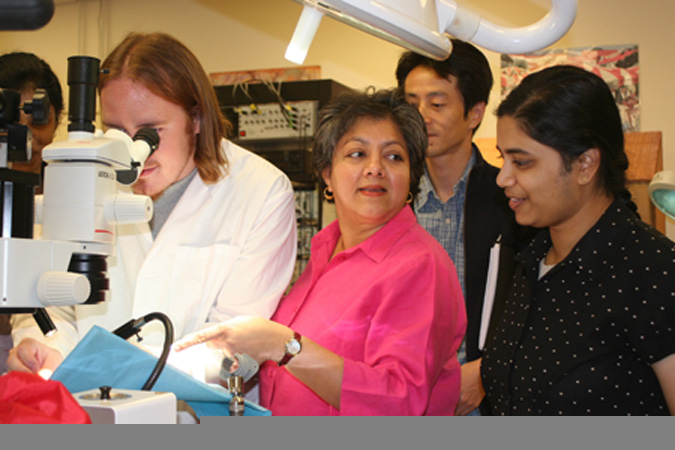When someone loses a limb to war, accident, or disease, she can get an artificial limb that restores some of her lost movement. But even the best prosthesis doesn’t restore the sense of touch. And touch is what lets you grip an egg tightly enough that it doesn’t fall but loosely enough that you don’t smash it.
Ranu Jung’s research aims to restore touch to arm and hand prostheses, an innovation that could help a mother missing a hand to feel the softness of her child’s cheek.
“We want to give as close to normal function back as we possibly can,” said Jung. The Wallace H. Coulter Eminent Scholars Chair of FIU’s biomedical engineering program leads the largest and most active such unit in Florida.

“There are soldiers who have lost their arms,” Jung said. Current technology lets them move an artificial limb by contracting their residual muscles, but “they don’t have touch sensation. Many of them are young. This is about giving them the ability to be working members of society and enabling them to live their lives in the full spectrum they should be able to.”
In another project, Jung is creating technology that may help a person regain function and improve recovery from partial paralysis after a spinal cord injury.
Thousands of new upper-body amputees each year – some 10,000 in the United States in 2009 alone, according to the non-profit Amputee Coalition – could benefit from her research, as could more than 1.3 million Americans who suffer from spinal cord injuries.
“Her work is very exciting and very promising,” said Grace Peng, program director with the National Institutes of Health’s National Institute of Biomedical Imaging and Bioengineering, which co-funds some of Jung’s research. “It’s going to affect the disability community as well as a lot of the veterans coming home.”
More than a Mechanical Hand
Unlike devices now available, the prosthesis Jung wants to develop will not simply attach to a person’s body; it will communicate with the nervous system as if it were a natural limb – a true bionic arm.
“We are calling it a neural-enabled prosthesis with sensorimotor integration,” she said. “It’s not just a mechanical hand. The goal is to provide the person with the sensation of touch – of the hand opening or closing. They are [also] controlling the prosthesis by signals from contracting muscles of the residual limb.”
The FIU team, led by Jung, is developing the technology for a wireless neural interface with the peripheral nerves in the arm. “It’s like a pacemaker for the nerves, but the pacemaker is transmitting information about sensation.”
The National Institutes of Health is providing $3.3 million to fund the project for five years. Jung’s work is part of a research partnership that includes medical device and prosthetic companies as well as clinicians. The work at FIU’s Adaptive Neural Systems Laboratory will include roughly 15 academic professionals by the end of 2011.
Other groups nationally and globally are also working to improve the control and function of prostheses. But Jung’s focus on allowing prostheses to give sensory feedback is unique, Peng said.
“We are fairly far ahead” in the research, Jung said. Her team looks forward to placing implants in test subjects at later stages.
Repairing Partial Paralysis
Jung’s work toward repairing partial paralysis has generated interest from the U.S. departments of Defense and Veterans Affairs. From car accident victims to soldiers with partial spinal cord injuries, Jung’s work could restore ability and independence.
She is researching the development of “smart neuroprostheses.”
“For people with neurological damage, such as spinal cord injury, it is not a matter of replacing a lost limb but replacing lost neural function, “Jung said. “We are basically developing adaptive software that is used to replace the lost neural control [of, say, leg muscles] versus replacing the actual physical [leg] itself.”
FIU researchers hope to develop software for a computer chip that would interface with the actual peripheral nerve and spinal systems. The software would control devices that electronically stimulate the intact nerves left behind in someone with a partial spinal cord injury, providing electrically stimulated exercise therapy.
To design the algorithm, Jung studies “the way the nervous system would do it,” she said. “We wouldn’t replace the injured spinal cord, but the exercise therapy may promote adaptation in the spinal circuits so they repair themselves after a partial injury. We already have some collaborators working to make such electrically stimulated exercise therapy available.” Jung is pursuing grants for her neuroprosthesis work.
“It’s not going to be one single magic bullet,” she said, but “many people are working on different parts of the puzzle.”
by Karen Cochrane
source: https://news.fiu.edu/2012/01/of-life-and-limb/34616
